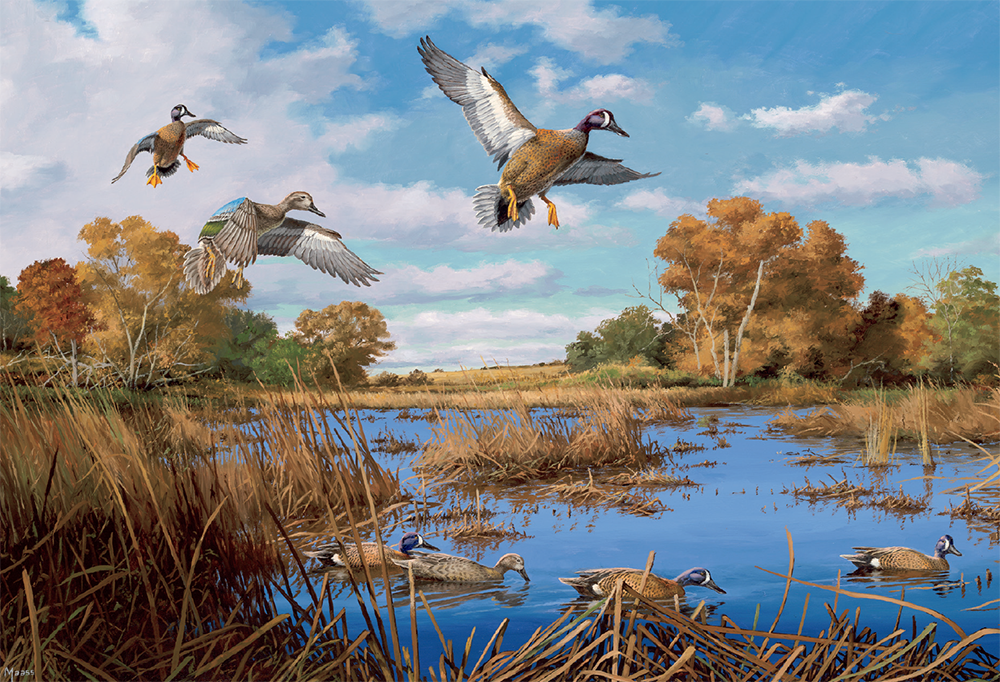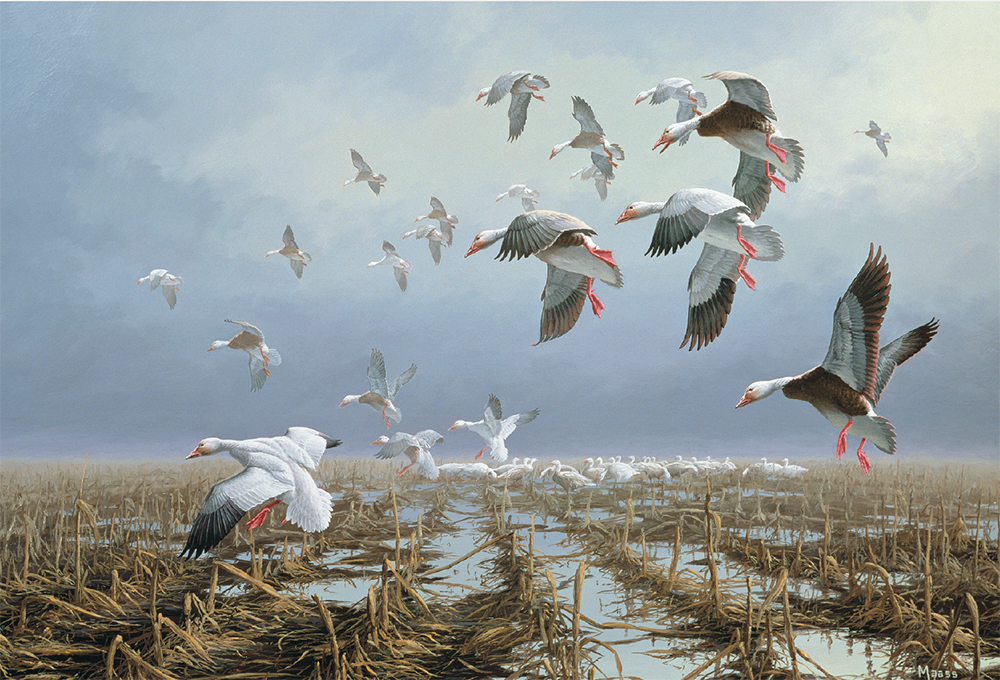
The art of bringing wildfowl imagery to millions.
by Brooke Chilvers
The numbers alone are remarkable. For decades, David Maass produced 70 major works a year. Today, as he approaches age 90, he still completes 6 to 10 large original oils—half are commissioned and half are issued by Wild Wings, LL C, as signed and numbered limited-edition prints. Maass’s relationship with Wild Wings dates back to the 1970s, and in the 1980s, when Wild Wings mailed out a million catalogs each year, the partnership established his popularity and reputation. In fact, over the last 45 years, he has painted some 250 of its titles and signed more than 250,000 of its prints, making this collaboration one of the longest, happiest, and most commercially successful in the art-publishing business.

Blue-winged Rendezvous—Blue-winged Teal
Born in Minnesota in 1929, Maass has other happy collaborations, too. For 50 years, his crisply colored artwork has appeared on Brown & Bigelow’s Wilderness Wings calendars, and his three-plate series (Pheasant, On the Wing, and Ducks Taking Flight) for the Danbury Mint are highly collectible.
Maass is known for tightly composed works that are graced with the eye of a graphic designer, as exemplified in his two Federal Duck stamps: 1974–75 for two wood ducks in flight and 1982–83 for three canvasbacks stroking powerfully over windblown waters. He’s also painted a total of 38 state and conservation stamps for organizations including Pheasants Forever, National Wild Turkey Federation, and Ruffed Grouse Society.

Daybreak at Lake Pepin—Canvasbacks
In addition, all three of his books are classics: A Gallery of Waterfowl and Upland Birds (1978), with text by Gene Hill; and The Wildfowl Art of David Maass (1990) and Wildfowl of North America (1999), both with Michael McIntosh. But he considers being named Ducks Unlimited’s Artist of the Year a record-breaking five times (1974, 1988, 2005, 2013, and 2016) his greatest personal achievement.
The broad appeal of this disciplined, self-taught artist, who has gladly consecrated nearly his entire talent to the depiction of several dozen wildfowl species in all seasons and all weathers, has introduced fine game bird art into countless homes.

Heart of the Timber—Mallards
Maass uses his own photos to reference fleeting details of ever-changing skies and the complex light effects of sunshine on water, snow, or ice. His creative process starts at the drawing board, where everything is worked out in advance and nothing is left to chance once he begins mixing paints, a process that takes an hour or two. Improvisation is not his thing: “I want to paint it exactly as I drew it.”
Whether spring or autumn, or wetlands, prairie potholes, or the flooded timber preferred by wood ducks and mallards, Maass works from the background forward, and from the sky downward, painting lastly the penciled-in primary subject. He paints quickly, “wet on wet,” with a surprisingly loaded brush. This allows him a softer touch when grading the relative lightness or darkness of a color—its “value”—according to the subject’s distance from the viewer.

Low Ceiling—Snows and Blues
Maass varies horizons, setting them high when he wants plenty of foreground to expand his birds’ habitat or activities, as in First Snow—Chukar Partridge, which provides a dramatic, wintry mountain landscape. In Winging Over—Canada Geese, the background is nothing but a temperamental sky.
The points of view for his paintings are inherently those of the hunters. In works such as Hasty Ascent—Pheasant, he immortalizes his childhood spent chasing pheasants down weather-battered rows of corn, flushing them toward his parents’ raised shotguns. Maass attributes his love of sport to Kelly, who’d turned his mother, Ora, into the winner of the Women’s Division of the Minnesota State Trapshooting Championships; he remembers her on Rice Lake, almost nonchalantly bagging two blue-winged teal.
Maass shot his first duck at age 12 over a dozen of Kelly’s old wooden mallard decoys. Since then, although his fans are spread across the continent, he’s never lived far from Minnesota duck habitat. Today, he lives on Lake Minnetonka, west of Minneapolis. The artist’s life is like a Maass painting—every day a new dawning with its flighting wildfowl.
•All images courtesy of the artist and Wild Wings, Lake City, Minnesota
